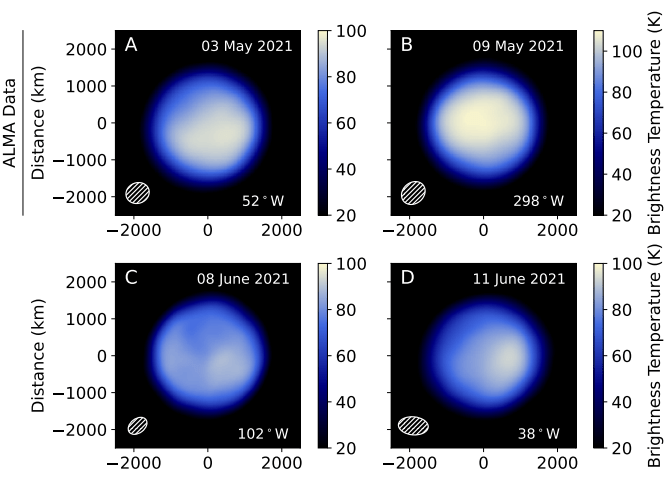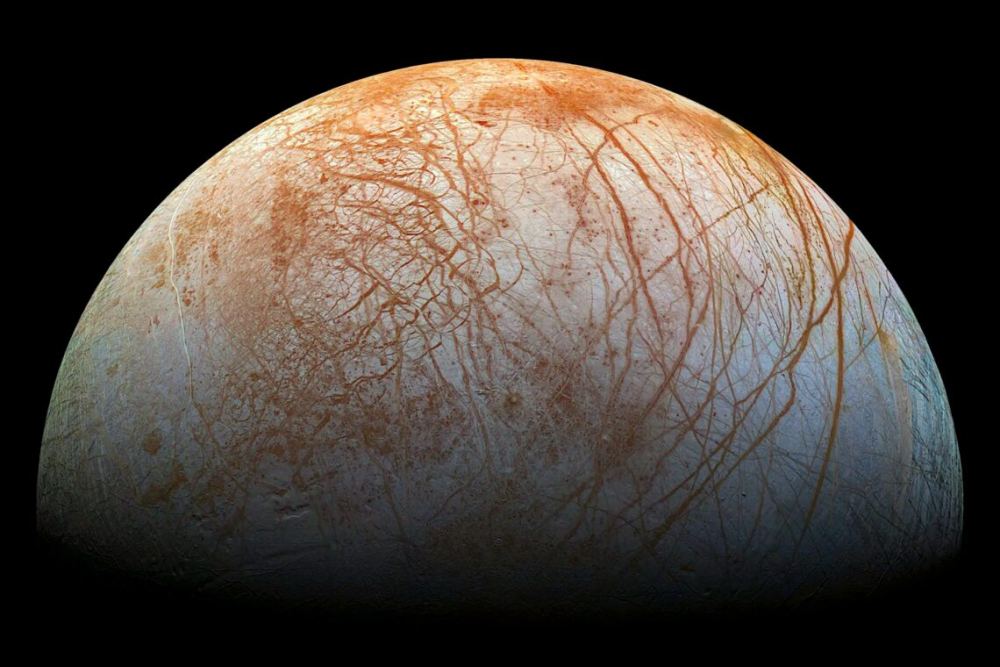In 2013, the Hubble Space Telescope spotted water vapour on Jupiter’s moon Europa. The vapour was evidence of plumes similar to the ones on Saturn’s moon Enceladus. That, and other compelling evidence, showed that the moon has an ocean. That led to speculation that the ocean could harbour life.
But the ocean is obscured under a thick, global layer of ice, making the plumes our only way of examining the ocean. The plumes are so difficult to detect they haven’t been confirmed.
The lead author of the paper presenting Hubble’s 2013 evidence is Lorenz Roth of Southwest Research Institute. He said, “By far, the simplest explanation for this water vapour is that it erupted from plumes on the surface of Europa. If those plumes are connected with the subsurface water ocean we are confident exists under Europa’s crust, then this means that future investigations can directly investigate the chemical makeup of Europa’s potentially habitable environment without drilling through layers of ice. And that is tremendously exciting.”
It is, but first, scientists have to find the plumes.
“We pushed Hubble to its limits to see this very faint emission. These could be stealth plumes because they might be tenuous and difficult to observe in visible light,” said Joachim Saur of the University of Cologne, co-author of the 2013 paper.

Describing them as tenuous stealth plumes turned out to be prophetic.
Recently, a team of researchers went looking for the plumes. Their results are in a presentation given to the IAU Symposium 383 titled “ALMA Spectroscopy of Europa: A Search for Active Plumes.” The lead author is M.A. Cordiner from the Solar System Exploration Division at NASA’s Goddard Space Flight Center.
“The subsurface ocean of Europa is a high-priority target in the search for extraterrestrial life, but direct investigations are hindered by the presence of a thick exterior ice shell,” the authors write. The researchers used ALMA to search for molecular emissions from atmospheric plumes. They were investigating processes under the ice that could help them understand Europa’s ocean and its chemistry.
The Solar System is full of icy bodies, including comets, Kuiper Belt Objects, dwarf planets, and moons like Europa. Europa has a high density compared to other icy bodies, indicating a substantial rocky interior. Its ocean makes up about 10% of the moon and is covered by an icy shell of uncertain thickness. It could be several tens of kilometres thick. Scientists learned much of this from NASA’s Galileo mission.
In recent years, Europa and its ocean have leapt to the top of the list of targets in the search for life. The reasons aren’t obscure: liquid water is an irresistible beacon in our search for habitable places. The plumes from Europa’s ocean are our only way to study the ocean and its potential habitability.

Over the years, different telescopes have examined Europa, searching for more evidence of the plumes. They’ve found potential intermittent plume activity near the moon’s south pole. But confirmation of the plumes the Hubble spotted in 2013 is elusive. In 2023, the JWST examined Europa. Those observations “found no evidence for active plumes, indicating that any present-day activity must be localized and weak; robust confirmation of the initial HST plume results also remains challenging,” the authors write.
In an attempt to find the plumes, the authors employed ALMA, the Atacama Large Millimeter/submillimeter Array. They observed Europa on four separate days to cover the moon’s surface. Unfortunately, they found no plumes.

“Despite near-complete coverage of both Europa’s leading and trailing hemispheres, we find no evidence for gas phase molecular absorption or emission in our ALMA data,” the researchers write. “Using ALMA’s unique combination of high spectral/spatial resolution and sensitivity, our observations have enabled the first dedicated search for HCN, H2CO, SO2 and CH3OH in Europa’s exosphere and plumes. No evidence was found for the presence of these molecules.”
Finding no evidence doesn’t quite mean that those molecules aren’t there. Rather, it means that if they are there, their concentrations are so low they’re below the detection threshold. In this case, some concentrations would be lower than those detected in Enceladus’ plumes, which are confirmed.
One chemical in particular illustrates this point: CH3OH (methanol.) “For the CH3OH abundance, on the
other hand, our ALMA upper limit of < 0.86% would not have been sensitive enough to detect this molecule at the Enceladus plume abundance of 0.02%,” the authors write.
There are some interesting relationships between Europa and other icy objects in the Solar System. It has to do with abundance limits. The researchers established upper limits for H2CO (formaldehyde) on Europa. “Indeed, our H2CO abundance upper limit is significantly lower than measured by Cassini in the Enceladus plume, implying a possible chemical difference.”
Despite the fact that it didn’t find any plumes, the observations were still valuable. By setting detection limits it helps subsequent efforts to search for them. And this won’t be scientists’ final attempt at finding plumes. Anything that provides clues to Europa’s ocean is too tantalizing to ignore, and this research shows that ALMA is suited to this type of investigation.
“Our results show that ALMA is a powerful tool in the search for outgassing from icy bodies within the Solar System and that follow-up searches for other molecules at additional epochs (on Europa and other icy bodies) are justified,” the researchers conclude.


Perhaps the water vapour detected in 2013 is the result of ionising radiation effects on the ice, liberating water molecules that are then trapped by the gravity of Europa, further, plumes that were detected could be the result of localised micrometeoritic activity or even bodies of a larger size – such as pebbles to few meter sized boulders.
Jupiter captures significant material, a lot of this must impact the moons of the planet, especially the Galilean worlds.
Not seeing formaldehyde means Europa organic nutrients is scarce, while it is a natural result of the serpentinization reactions believed to drive Enceladus vents.
@James Franklin: We can likely discount slow varying sources like radiation. And it seems the impactor hypothesis has been disfavored compared to geysers.